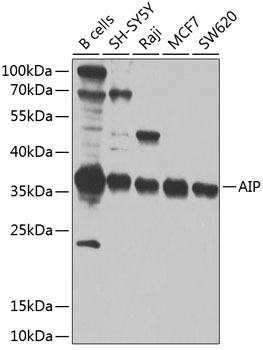ARA9 antibody [N1C3]
GTX110665
ApplicationsImmunoFluorescence, Western Blot, ImmunoCytoChemistry, ImmunoHistoChemistry, ImmunoHistoChemistry Paraffin
Product group Antibodies
TargetAIP
Overview
- SupplierGeneTex
- Product NameARA9 antibody [N1C3]
- Delivery Days Customer9
- Application Supplier NoteWB: 1:500-1:10000. ICC/IF: 1:100-1:1000. IHC-P: 1:100-1:1000. *Optimal dilutions/concentrations should be determined by the researcher.Not tested in other applications.
- ApplicationsImmunoFluorescence, Western Blot, ImmunoCytoChemistry, ImmunoHistoChemistry, ImmunoHistoChemistry Paraffin
- CertificationResearch Use Only
- ClonalityPolyclonal
- Concentration1 mg/ml
- ConjugateUnconjugated
- Gene ID9049
- Target nameAIP
- Target descriptionAHR interacting HSP90 co-chaperone
- Target synonymsARA9, FKBP16, FKBP37, PITA1, SMTPHN, XAP-2, XAP2, AH receptor-interacting protein, Ah receptor activated 9, FK506-binding protein 37, FKBP prolyl isomerase 16, HBV X-associated protein 2, X-associated protein-2, aryl hydrocarbon receptor interacting protein, aryl hydrocarbon receptor-associated protein 9, hepatitis B virus X-associated cellular protein 2, immunophilin homolog ARA9
- HostRabbit
- IsotypeIgG
- Protein IDO00170
- Protein NameAH receptor-interacting protein
- Scientific DescriptionThe protein encoded by this gene is a receptor for aryl hydrocarbons and a ligand-activated transcription factor. The encoded protein is found in the cytoplasm as part of a multiprotein complex, but upon binding of ligand is transported to the nucleus. This protein can regulate the expression of many xenobiotic metabolizing enzymes. Also, the encoded protein can bind specifically to and inhibit the activity of hepatitis B virus. [provided by RefSeq]
- Storage Instruction-20°C or -80°C,2°C to 8°C
- UNSPSC12352203
References
- Song D, Li LS, Heaton-Johnson KJ, et al. Prolyl hydroxylase domain protein 2 (PHD2) binds a Pro-Xaa-Leu-Glu motif, linking it to the heat shock protein 90 pathway. J Biol Chem. 2013,288(14):9662-9674. doi: 10.1074/jbc.M112.440552Read this paper





![WB analysis of mouse lung tissue using GTX20468 ARA9 antibody [35-2]. Loading : 30microg Dilution : 1:500](https://www.genetex.com/upload/website/prouct_img/normal/GTX20468/GTX20468_1125_WB_w_23060620_248.webp)

